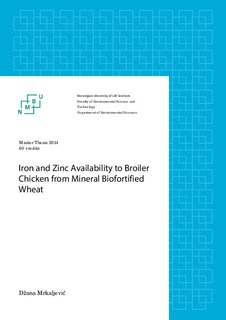| dc.description.abstract | This study was conducted to investigate the effect of mineral biofortified wheat with fungal
phytase addition on iron (Fe) and zinc (Zn) availability in broiler chicken breast muscle and
liver, their excretion in feces and digestibility in intestines. Furthermore, possible beneficial
effect on broiler performance was studied. 90 day-old Ross 308 broiler chickens were placed
in brooder cages and received commercial starter diet from day 1-7 posthatch and micromineral
deficient starter diet from day 7-11 posthatch. On 11 day posthatch 70 randomly
selected chickens were weighed, placed in individual cages and assigned to six experimental
diets and one commercial grower diet. Experimental diets consisted of three different
biofortified wheats as cereal components (difference is in the level of Fe and Zn in wheat),
soybean meal, soybean oil and contained titanium dioxide as an indigestible marker. Three
experimental diets were supplemented with recommended levels of fungal phytase. Broilers
were weighed again on 19 day posthatch and number was reduced to 49 (7 replicants per
diet). Feed intake and excreta output quantification was performed from day 19 until day 22
posthtach. On 22 day posthatch birds were killed by dislocation of their neck and samples of
liver and breast muscle were taken. All samples were analysed by ICP-MS. Excreta samples
were analysed to determine the excretion and digestibility of the Fe and Zn, and liver and
breast muscle samples were analysed in order to detect content of Fe and Zn. No differences
were observed for body weight gain, feed intake or feed conversion ratio among all different
dietary levels of Fe and Zn. Fecal mineral excretion increased linearly with increased levels of
Fe and Zn in biofortified wheat and it was significantly higher (P < 0.001) in control diet
when compared to experimental diets. Apperent digestibility of Fe increased linearly with
increased level of Fe in biofortified wheat, while digestibility of Zn decreased linearly with
increased levels of Zn in biofortified wheat. Highest digestibility of Fe was in diet with 220
mg Fe/kg diet and highest digestibility of Zn was in diet with 37 mg Zn/kg diet.
Supplementation of fungal phytase had no effect on broiler performance or mineral
digestibility in this study. Ova studija je provedena u cilju otkrivanje uticaja bio-fortificirane pšenice sa dodatkom
fungalne fitaze na dostupnost cinka (Zn) i željeza (Fe) u prsnom mišiću i jetri brojlera, te na
njihovu ekskreciju u fecesu i razgradivost u crijevima. Moguĉnost pozitivnog efekta na
performans brojlera je takoĊe bio jedan od ciljeva studije. 90 dan starih brojlera rase Ross 308
je postavljeno u kaveze i u prvih sedam dana života su hranjeni komercijalnom starter
dijetom, a od 7-11 dana života su hranjeni sa starter dijetom koja je deficitarna u mikro
mineralima. 11 dana života, 70 nasumiĉno odabranih pilića je izvagano i postavljeno u
individualne kaveze te im je za ishranu dodjeljena jedna od šest eksperimentalnih dijeta ili
komercijalna grover dijeta. Eksperimentalne dijete su sadržavale tri razliĉite vrste biofortificirane
pšenice kao osnovnu komponentu (razlike su bile u razini Fe i Zn u pšenici),
sojinu saĉmu, sojino ulje i titanium dioksid kao nerazgradivi marker. Tri eksperimentalne
dijete su suplementirane sa preporuĉenim koliĉinama fungalne fitaze. Pilići su ponovo
izvagani 19 dana života i broj pilića je smanje na 49 (7 replikanata po dijeti). Kvantitativno
mjerenje unosa hrane i ekskrecije je obavljeno od 19 do 22 dana života. 22 dana života pilići
su ubijeni metodom dislokacije vrata i uzorci prsnog mišića i jetre su uzeti. Uzorci ekskreta su
analizirani u cilju odreĊivanja ekskrecije i razgradivosti Fe i Zn a uzorci prsnog mišića i jetre
su analizirani u cilju odreĊivanja sadržaja Fe i Zn u njima. Nije uoĉena nikakva znaĉajna
razlika u težini, unosu hrane i konverziji hrane izmeĊu razliĉitih Fe i Zn. Mineralna ekskrecija
je linearno poveĉana sa poveĉanjem razine Fe i Zn u bio-fortificiranoj pšenici i bila je
znaĉajno veĉa (P < 0.001) u kontrolnoj dijeti nego u eksperimentalnim dijetama. Razgradivost
Fe je linearno poveĉana sa poveĉanjem razine Fe u bio-fortificiranoj pšenici, dok je
razgradivost Zn linearno smanjena sa poveĉanjem razine Zn u bio-fortificiranoj pšenici.
Najveĉa razgradivost Fe je uoĉena kod dijete sa 220 mg Fe/kg dijete dok je najveĉa
razgradivost cinka uoĉena kod dijete sa 37 mg Zn/kg dijete. Suplementacija fungalne fitaze
nije imala znaĉajan efekat na performans brojlera ili razgradivost mineral u ovoj studiji. | nb_NO |

